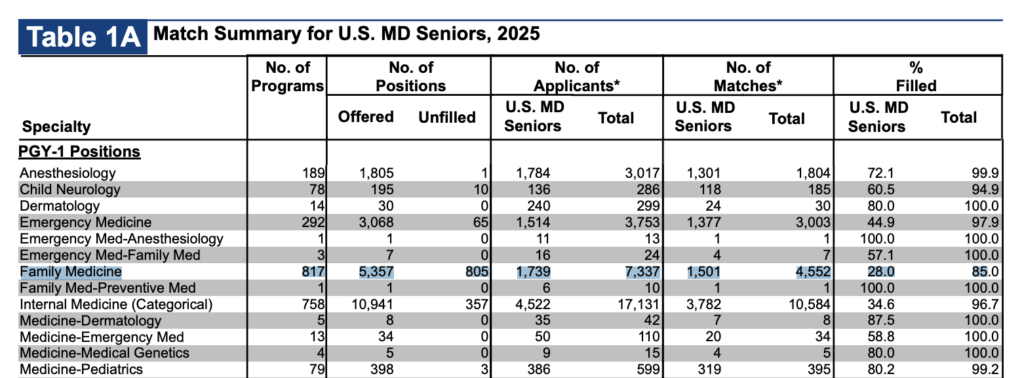In the 1960s, economist William Baumol attempted to explain why services like healthcare and education keep getting more expensive: they’re labor-intensive, and there’s a ceiling on how much productivity can improve without sacrificing quality.
This idea—known as Baumol’s cost disease—goes like this:
- In sectors like manufacturing or tech, productivity is routinely increasing. You can automate, outsource, and scale (often all three).
- In labor-intensive fields like medicine or education, that’s a lot harder. You can’t operate on two people at once or scale up human empathy. A physician visit in 2025 takes the same amount of time as one in 1995 (okay, a maybe half as long because healthcare is terrible now).
The “disease,” according to Baumol? Wages still rise across the board, even in those low-productivity-growth fields.
Why?
Because the cardiologist isn’t just competing against other doctors—she’s also competing against the broader economy. If productivity increases in other sectors boost wages, medicine has to keep up just to retain talent.
This means that costs rise even if productivity doesn’t.
So why hasn’t physician pay risen?
If you follow Baumol’s logic, we should expect physician pay to have risen steadily just to track broader wage inflation. But that’s not what Medicare has done.
- The Medicare Physician Fee Schedule uses a conversion factor to translate RVUs into actual payment.
- That conversion factor has fallen from $36.78 in 1998 to $32.74 in 2024—and that’s before inflation.
- Adjusted for inflation, that’s a real pay cut of over 40% per RVU.
The government that sets the rules is also the dominant customer setting the prices.
Physicians are providing the same service (and often more of it), with higher expectations, greater documentation, and more liability—and getting paid less to do it.
This is the exact opposite of what Baumol’s model would predict.
Rising costs, falling pay
The paradox: overall healthcare cost increases are outpacing inflation even though clinician pay is falling in real terms. If Baumol’s cost disease is supposed to explain rising prices due to rising wages in stagnant-labor sectors, then how can healthcare spending keep growing when labor (e.g. doctors and nurses) is squeezed?
Because labor isn’t the main thing driving healthcare costs.
The three dominant forces:
1. Regulation & administrative bloat
Healthcare hasn’t just added labor—it’s added layers. In the U.S., we have more administrators per capita than any other country, and the fastest growth in healthcare employment has been in non-clinical roles.
We’ve created a complex system that requires armies of coders, billers, compliance officers, prior auth specialists, and case managers just to keep the machine moving. These people may be necessary to varying degrees, and some may unlock revenue through their work, but none generate revenue through patient care: they are, on the whole, a drag that adds cost to the system.
Baumol predicted rising costs due to labor intensity, not bureaucratic overgrowth. The U.S. did both.
2. Technology that adds cost more than efficiency
In theory, technology should help reduce costs by boosting productivity. But in healthcare, it often adds capabilities rather than replaces old ones.
-
MRI didn’t replace the physical exam. It just got added to the diagnostic workflow. (Okay maybe that one is a bad example.)
-
Robotic surgery didn’t make operations faster or cheaper. It made them more expensive—and arguably more marketable.
- EMRs don’t actually make charting more efficient, because they allow for more elaborate and demanding documentation rules.
On the whole, new certainly doesn’t mean cheaper.
3. The disconnect & moral hazard of third-party payment
Unlike most sectors, patients don’t directly pay for services. That disconnect between consumption and payment drives demand beyond what you’d see in other labor-intensive industries. As in, when you think a physician visit actually costs a $35 copay with infinite free mychart messages after, you have no idea what you’re really asking for.
Insurers buffer the cost, employers shift premiums, and the government subsidizes the system. We’ve uncoupled the market forces of supply and demand.
So of course we want the newest, shiniest things, and when insurance “pays” for it, there’s little incentive to say no. Combine that with medicolegal defensive medicine and the customer-service/patient-satisfaction mindset, and it’s only worse.
Structural forces vs. policy levers
Baumol’s cost disease explains why costs in healthcare should rise: it’s structurally labor-bound. But instead of acknowledging that, Medicare has tried to hold the line on overall costs by cutting per-unit reimbursement. This creates a massive disconnect between how much it costs to provide care and how much physicians are paid to do it. Meanwhile, we have sabotaged ourselves with processes and guardrails without really figuring out long-term when they’re actually helping and removing the ones that don’t. We are awash in open-loop errors.
This is why independent practice is vanishing. It’s why private equity has a foothold. It’s why primary care is on life support and many doctors are shifting toward concierge and other DPC models to opt out of the system. Practices get squeezed, so they look for scale and efficiency—not for better care, but for survival.
Private insurance, everyone’s favorite bogeyman, picks up some slack by paying more than the government (and profiting handsomely as a middleman processing claims), but even that’s tied to underlying government payments. So we see further consolidation, burnout, cost-shifting, and administrative creep.
Bigger doesn’t mean better, but it does mean more negotiating clout.
The deeper tension
This is the heart of the issue:
Natural economic forces push healthcare costs up.
Political mechanisms try to push them down.
Even well-intentioned regulations are converted to pure bloat or subverted by administrative capture, resulting in painful and expensive inefficiencies as compliance becomes the dominant force in healthcare.
And in between is the physician workforce, stuck trying to deliver high-quality care under increasingly unsustainable conditions.
